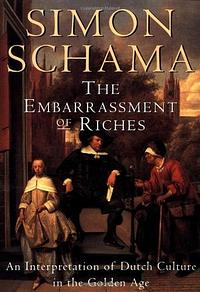You need to sign in or sign up before continuing.
Take a photo of a barcode or cover
17 reviews for:
The Embarrassment of Riches: An Interpretation of Dutch Culture in the Golden Age
Simon Schama
17 reviews for:
The Embarrassment of Riches: An Interpretation of Dutch Culture in the Golden Age
Simon Schama
I was fortunate enough to use a passport in the summer of 2022 for the first time since 1982. I was blessed to be the guest of my college friend Paul and his husband Hugo in their home, located in the Netherlands--Edam, 30 or so km north of Amsterdam. Paul was very generous to include this book as a gift, and I read about a quarter of it during my week in Edam.
The Dutch elite in the 16th and 17th centuries were amazing people: paradoxically industrious, I think to survive in their harsh landscape that needs constant management of the movement of water relative to their houses, roads, and other structures. The Dutch (at least of the 15th and 16th Centuries) were compelled by their Calvinist religion to be modest, hence the book's title. By my observation, the Dutch still remain highly pragmatic (and a bit blunt).
Schama, a professor of history and art history at Columbia U, makes copious use of artwork to support his claims about the culture of the Dutch during their decades of great achievement (fueled in part by colonization).
I'm probably not going to finish this book by the year's end (given my teaching load this fall), but here is my progress so far:
Introduction: The Batavian Temperament. The intro declares the intent (with a bit of fear and trembling) of sketching the _conscience collectif_ of the elite Dutch during their country's peak.
Part One: Becoming.
Ch. 1 Moral Geography. If the Dutch are not moral, God will use floods and sea storms to humble the Dutch. Until I visited, I could not really understand the high degree of water management required to survive: ports, dams, locks, canals, etc. Water, water everywhere.
Ch. 2 Patriotic Scripture. The Dutch forged their identity in part in opposition to Catholic Spaniards who invaded / occupied (1556-1714) the southern part what-is-now the Netherlands (and into Belgium and northern France).
Part Two: Doing and Not Doing
Ch. 3 Feasting, Fasting and Timely Atonement describes how artwork of beached whales convey information about "the peculiar Dutch relation with fortune, nature and history" (132). I would add theology as well.
Ch. 4 The Impertinence of Survival
Ch. 5 The Embarrassment of Riches
Part Three: Living and Growing
Ch. 6 Housewives and Hussies: Homeliness and Worldliness
Ch. 7 In the Republic of Children
Part Four: Watersheds
Ch. 8 Inside, Outside
Lector Et Emergo
Appendices
The Dutch elite in the 16th and 17th centuries were amazing people: paradoxically industrious, I think to survive in their harsh landscape that needs constant management of the movement of water relative to their houses, roads, and other structures. The Dutch (at least of the 15th and 16th Centuries) were compelled by their Calvinist religion to be modest, hence the book's title. By my observation, the Dutch still remain highly pragmatic (and a bit blunt).
Schama, a professor of history and art history at Columbia U, makes copious use of artwork to support his claims about the culture of the Dutch during their decades of great achievement (fueled in part by colonization).
I'm probably not going to finish this book by the year's end (given my teaching load this fall), but here is my progress so far:
Introduction: The Batavian Temperament. The intro declares the intent (with a bit of fear and trembling) of sketching the _conscience collectif_ of the elite Dutch during their country's peak.
Part One: Becoming.
Ch. 1 Moral Geography. If the Dutch are not moral, God will use floods and sea storms to humble the Dutch. Until I visited, I could not really understand the high degree of water management required to survive: ports, dams, locks, canals, etc. Water, water everywhere.
Ch. 2 Patriotic Scripture. The Dutch forged their identity in part in opposition to Catholic Spaniards who invaded / occupied (1556-1714) the southern part what-is-now the Netherlands (and into Belgium and northern France).
Part Two: Doing and Not Doing
Ch. 3 Feasting, Fasting and Timely Atonement describes how artwork of beached whales convey information about "the peculiar Dutch relation with fortune, nature and history" (132). I would add theology as well.
Ch. 4 The Impertinence of Survival
Ch. 5 The Embarrassment of Riches
Part Three: Living and Growing
Ch. 6 Housewives and Hussies: Homeliness and Worldliness
Ch. 7 In the Republic of Children
Part Four: Watersheds
Ch. 8 Inside, Outside
Lector Et Emergo
Appendices
challenging
informative
slow-paced
A very good book on a somewhat esoteric subject, but a very worthwhile read. Beware: it is challenging and should be read methodically and slowly.
This book takes an interestingly different tack. As a 'cultural' history it makes no concession to narrative history, instead assuming that the reader is already at least somewhat familiar with the basic story of the early years of the Dutch Republic from the late 16th to the early 18th century. That said, I am only very roughly familiar with the period, but still found Schama's book an interesting read.
Schama uses a variety of starting points to discuss various elements in the development of a specifically Dutch culture. Things as varied as the interest in whale beachings, the inundation disasters, and the various approaches to childhood. Schama's interest is wide ranging and eclectic, and very strongly linked to the art of the period. The links he creates between the wider culture and both the high- and low-brow art of the period are insightful. If nothing else, this is a book to read before you visit the Rijksmuseum.
In particular Schama draws out the contradiction between the riches accumulated by the emerging mercantile capitalism of the Netherlands and domestic culture with an emphasis on a lack of ostentation, belief in the family, and approach to charity. Schama's thesis is that the Weberian emphasis on Calvinist asceticism as underpinning Dutch culture and the growth of a nascent capitalism is misguided. That Dutch culture is more complex than that.
This is not a Marxist history, economics and social structure do not feature. But as a detailed exploration of culture in the Dutch golden age with a strong emphasis on the art of the period, its different approach is fascinating.
Schama uses a variety of starting points to discuss various elements in the development of a specifically Dutch culture. Things as varied as the interest in whale beachings, the inundation disasters, and the various approaches to childhood. Schama's interest is wide ranging and eclectic, and very strongly linked to the art of the period. The links he creates between the wider culture and both the high- and low-brow art of the period are insightful. If nothing else, this is a book to read before you visit the Rijksmuseum.
In particular Schama draws out the contradiction between the riches accumulated by the emerging mercantile capitalism of the Netherlands and domestic culture with an emphasis on a lack of ostentation, belief in the family, and approach to charity. Schama's thesis is that the Weberian emphasis on Calvinist asceticism as underpinning Dutch culture and the growth of a nascent capitalism is misguided. That Dutch culture is more complex than that.
This is not a Marxist history, economics and social structure do not feature. But as a detailed exploration of culture in the Dutch golden age with a strong emphasis on the art of the period, its different approach is fascinating.
informative
reflective
medium-paced
Moderate: Homophobia
challenging
informative
reflective
slow-paced
informative
slow-paced
Extremely thorough and encompassing, just a little dense and dry for my personal taste.
Great history of 17th century Dutch life. Very entertaining. Schama talks about the daily life of the Dutch.
Schama is a master of telling historical stories. This book was hard to put down.
See also Schama's BBC series, The Power of Art. Simply fantastic.
See also Schama's BBC series, The Power of Art. Simply fantastic.
Quite impressive overview of the culture in the Dutch Republic of the 17th Century. In just 2 generations this new country became an economic, diplomatic and cultural giant. Schama zooms in on how the cultural elite of the republic looked at this very steep rise: certainly with awe and pride, but also with some feelings of uneasiness and discomfort. Nicely done, but to my taste, Schama is a bit too dependent on the pictural arts. (3.5 stars)
We, when it was still me and Mariella, bought this book in 1993.
Who said I'm a slow reader.
Can't wait to finish.
The cover brings back the memories of some years after 1996 when I roamed old Delft, while working for IRCwash.org.
Who said I'm a slow reader.
Can't wait to finish.
The cover brings back the memories of some years after 1996 when I roamed old Delft, while working for IRCwash.org.




